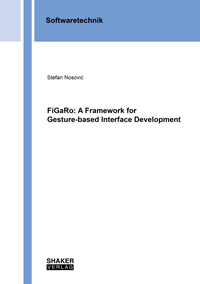
Shop : Link
Shop
Link
45,80 €ISBN 978-3-8440-6636-4Softcover140 pages67 figures206 g29,7 x 21,0 cmEnglishThesis
May 2019
New publication
Stefan Nosovic
FiGaRo: A Framework for Gesture-based Interface Development
To talk to computers, one has to interact with them. Human computer interaction (HCI) studies human behavior and develops the technology for making this interaction more efficient and natural. Graphical user interface based and speech-based interactions are reaching their limitations in situations when quick interactions are required in noisy environments, such as factory floors, where workers interact with computers to create products. In these situations, hand gesture-based interfaces are often more appropriate.
Building a hand gesture-based interface for arbitrary applications is time consuming for the developers. It has a steep learning curve because of the complexity of hand gesture recognition algorithms. In addition, developers lack tools for designing and formalizing hand gesture-based interfaces. Another developer challenge is to offer customizable gesture-based interfaces to users, so that they can adapt the gestures and make them easy to memorize.
This dissertation introduces FIGARO, a framework for the development of hand gesture-based interfaces. Its goal is to flatten the learning curve and to enable faster development of gesture-based user interfaces for arbitrary applications. FIGARO facilitates the definition and recognition of new hand gestures. It was designed to be extensible with respect to hand gestures and hand gesture recognition algorithms. FIGARO is based on GIML, a metamodel that allows formalization of hand gesture-based interfaces.
The viability of the FIGARO framework was evaluated through the development of gesture-based interfaces for four legacy applications. The applications originate from four domains: education, entertainment, smart environment control and medical equipment operation. The goal was to demonstrate that FIGARO can be used for the development of gesture-based interfaces for arbitrary applications. Furthermore, we compare the development times of the legacy gesture-based interfaces with the development times using the FIGARO framework. The first gesture-based interface enabled conducting a virtual orchestra with a 3D printed baton. The second gesture-based interface was for an augmented reality application teaching human anatomy by visualizing organs inside a body. The third gesture-based interface was for a remote control of an x-ray machine with a mobile device. The fourth gesture-based interface targeted controlling of the light bulbs and blinds in a smart house. The development of each of these four gesture-based interfaces with FIGARO led to a reduction of the development time compared to the legacy interfaces by at least 67 percent.
Building a hand gesture-based interface for arbitrary applications is time consuming for the developers. It has a steep learning curve because of the complexity of hand gesture recognition algorithms. In addition, developers lack tools for designing and formalizing hand gesture-based interfaces. Another developer challenge is to offer customizable gesture-based interfaces to users, so that they can adapt the gestures and make them easy to memorize.
This dissertation introduces FIGARO, a framework for the development of hand gesture-based interfaces. Its goal is to flatten the learning curve and to enable faster development of gesture-based user interfaces for arbitrary applications. FIGARO facilitates the definition and recognition of new hand gestures. It was designed to be extensible with respect to hand gestures and hand gesture recognition algorithms. FIGARO is based on GIML, a metamodel that allows formalization of hand gesture-based interfaces.
The viability of the FIGARO framework was evaluated through the development of gesture-based interfaces for four legacy applications. The applications originate from four domains: education, entertainment, smart environment control and medical equipment operation. The goal was to demonstrate that FIGARO can be used for the development of gesture-based interfaces for arbitrary applications. Furthermore, we compare the development times of the legacy gesture-based interfaces with the development times using the FIGARO framework. The first gesture-based interface enabled conducting a virtual orchestra with a 3D printed baton. The second gesture-based interface was for an augmented reality application teaching human anatomy by visualizing organs inside a body. The third gesture-based interface was for a remote control of an x-ray machine with a mobile device. The fourth gesture-based interface targeted controlling of the light bulbs and blinds in a smart house. The development of each of these four gesture-based interfaces with FIGARO led to a reduction of the development time compared to the legacy interfaces by at least 67 percent.
Keywords: hand gestures; gesture recognition; gesture-based interface; FiGaRo; Human computer interaction (HCI)
Link to the book
Simply copy the following lines into your HTML document:
The book <a href="https://www.shaker.eu/shop/978-3-8440-6636-4">Stefan Nosovic - FiGaRo: A Framework for Gesture-based Interface Development</a><br />(ISBN: 978-3-8440-6636-4) was published by <a href="https://www.shaker.eu">Shaker Verlag</a>.
Result:
The book Stefan Nosovic - FiGaRo: A Framework for Gesture-based Interface Development
(ISBN: 978-3-8440-6636-4) was published by Shaker Verlag.
(ISBN: 978-3-8440-6636-4) was published by Shaker Verlag.
Link to the series
Simply copy the following lines into your HTML document:
The series <a href="https://www.shaker.eu/Series/114">Berichte aus der Softwaretechnik</a> is published by <a href="https://www.shaker.eu">Shaker Verlag</a>.
Result:
The series Berichte aus der Softwaretechnik
is published by Shaker Verlag.
Shaker Verlag GmbH
Am Langen Graben 15a
52353 Düren
Germany
Am Langen Graben 15a
52353 Düren
Germany
Mon. - Thurs. 8:00 a.m. to 4:00 p.m.
Fri. 8:00 a.m. to 3:00 p.m.
Fri. 8:00 a.m. to 3:00 p.m.
Contact us. We will be happy to help you.



